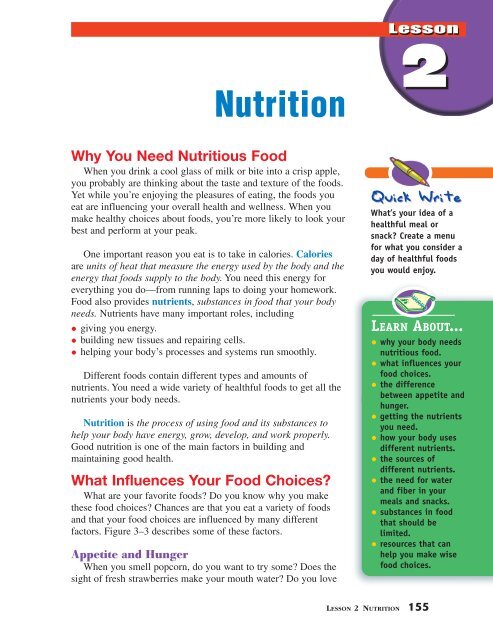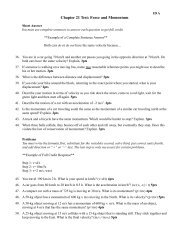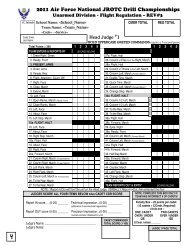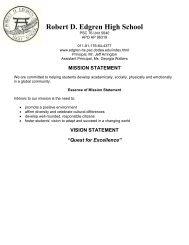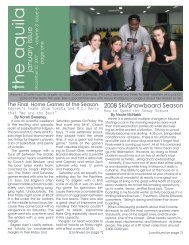AFJROTC Student Workbook CH03_Lesson_2 - Edgren High ...
AFJROTC Student Workbook CH03_Lesson_2 - Edgren High ...
AFJROTC Student Workbook CH03_Lesson_2 - Edgren High ...
Create successful ePaper yourself
Turn your PDF publications into a flip-book with our unique Google optimized e-Paper software.
<strong>CH03</strong>_LE1 6/28/05 4:19 PM Page 155<br />
Nutrition<br />
<strong>Lesson</strong><br />
2<br />
Why You Need Nutritious Food<br />
When you drink a cool glass of milk or bite into a crisp apple,<br />
you probably are thinking about the taste and texture of the foods.<br />
Yet while you’re enjoying the pleasures of eating, the foods you<br />
eat are influencing your overall health and wellness. When you<br />
make healthy choices about foods, you’re more likely to look your<br />
best and perform at your peak.<br />
One important reason you eat is to take in calories. Calories<br />
are units of heat that measure the energy used by the body and the<br />
energy that foods supply to the body. You need this energy for<br />
everything you do—from running laps to doing your homework.<br />
Food also provides nutrients, substances in food that your body<br />
needs. Nutrients have many important roles, including<br />
giving you energy.<br />
building new tissues and repairing cells.<br />
• helping your body’s processes and systems run smoothly.<br />
Different foods contain different types and amounts of<br />
nutrients. You need a wide variety of healthful foods to get all the<br />
nutrients your body needs.<br />
Nutrition is the process of using food and its substances to<br />
help your body have energy, grow, develop, and work properly.<br />
Good nutrition is one of the main factors in building and<br />
maintaining good health.<br />
What Influences Your Food Choices<br />
What are your favorite foods Do you know why you make<br />
these food choices Chances are that you eat a variety of foods<br />
and that your food choices are influenced by many different<br />
factors. Figure 3–3 describes some of these factors.<br />
Appetite and Hunger<br />
When you smell popcorn, do you want to try some Does the<br />
sight of fresh strawberries make your mouth water Do you love<br />
Quick Write<br />
What’s your idea of a<br />
healthful meal or<br />
snack Create a menu<br />
for what you consider a<br />
day of healthful foods<br />
you would enjoy.<br />
LEARN ABOUT...<br />
• why your body needs<br />
nutritious food.<br />
• what influences your<br />
food choices.<br />
• the difference<br />
between appetite and<br />
hunger.<br />
• getting the nutrients<br />
you need.<br />
• how your body uses<br />
different nutrients.<br />
• the sources of<br />
different nutrients.<br />
• the need for water<br />
and fiber in your<br />
meals and snacks.<br />
• substances in food<br />
that should be<br />
limited.<br />
• resources that can<br />
help you make wise<br />
food choices.<br />
LESSON 2 NUTRITION 155
<strong>CH03</strong>_LE1 6/28/05 4:19 PM Page 156<br />
LEARN ABOUT...<br />
• balancing the<br />
different foods you<br />
eat.<br />
• using the nutrition<br />
information on food<br />
labels.<br />
VOCABULARY<br />
• calories<br />
• nutrients<br />
• nutrition<br />
• appetite<br />
• hunger<br />
• nutrient deficiency<br />
• carbohydrates<br />
• proteins<br />
• amino acids<br />
• saturated fats<br />
• unsaturated fats<br />
• triglycerides<br />
• vitamins<br />
• minerals<br />
• fiber<br />
• trans fatty acids<br />
• cholesterol<br />
• Dietary Guidelines for<br />
Americans<br />
• foodborne illness<br />
• Percent Daily Value<br />
to crunch on fresh carrots These are signs of your appetite at<br />
work. Your appetite is the psychological desire for food. It may be<br />
stimulated by the smell, sight, or texture of food.<br />
Appetite is different from hunger. Hunger is the physical need<br />
for food. When you are hungry, your brain sends a signal to find<br />
food. You may hear your stomach growl or feel it contract. You<br />
may also feel tired or light-headed. These signs indicate that your<br />
body’s supply of food energy and nutrients is running low.<br />
When you eat, the hunger gradually goes away. Your stomach<br />
needs about 20 minutes to send a message back to the brain to turn<br />
off the hunger switch. Eating slowly allows time for your brain to<br />
receive the message. Many people overeat when they eat too fast.<br />
Food and Emotions<br />
Food can meet emotional needs too. Do certain foods that you<br />
associate with special events bring you happy memories Perhaps<br />
you have favorite foods that comfort you when you are feeling ill<br />
or sad. Using food as a way of dealing with negative emotions is<br />
not a healthy way to respond to these feelings. People who eat to<br />
relieve stress or boredom need to develop more appropriate coping<br />
skills.<br />
Getting the Nutrients You Need<br />
Everyone needs the same nutrients to maintain good health, but<br />
the amount of nutrients needed depends on a person’s age, gender,<br />
state of health, and level of activity. When you do not get enough<br />
of a particular nutrient, you could have a nutrient deficiency, a<br />
shortage of a nutrient.<br />
As a teen, you need more calcium than you did before for<br />
building strong and growing bones. However, suppose you don’t<br />
eat enough foods that supply calcium. Over time, the calcium deficiency could affect<br />
the strength of your teeth and bones. A food plan that includes calcium-rich foods<br />
helps prevent osteoporosis, a disease in which bones become brittle and more liable to<br />
break. You also need more iron because your body makes more red blood cells as you<br />
grow. A shortage of iron can lead to a blood disease called anemia. In general, teens<br />
need more of most nutrients to support growth and satisfy energy needs.<br />
Most people in the United States get plenty of food, yet many still do not get the<br />
nutrients they need. This is partly the result of lifestyles that tend to encourage fast<br />
foods and promote foods that are high in fat and sugar. Eating low-nutrient, high-fat<br />
foods, along with overeating, can lead to long-term health problems such as heart<br />
disease, cancer, and diabetes. Your nutritional knowledge and healthy eating habits are<br />
your best defense against poor nutrition.<br />
156 CHAPTER 3 BE HEALTH SMART
<strong>CH03</strong>_LE1 6/28/05 4:19 PM Page 157<br />
FIGURE 3–3.<br />
FACTORS THAT INFLUENCE FOOD CHOICES<br />
Factors<br />
Family and friends<br />
Cultural background<br />
Food availability<br />
Time and money<br />
resources<br />
Advertising<br />
Knowledge of<br />
nutrition<br />
Personal preferences<br />
Description<br />
You may prefer certain foods, like burritos or vegetable stir-fry, because you<br />
have grown up eating them at home. At the same time, your friends may<br />
persuade you to try new and different foods.<br />
Different cultures have different traditions about what they eat, and perhaps<br />
where, how, and with whom they eat. For example, Mexican American<br />
families may eat beans, corn, and tortillas, while Italian American families<br />
may favor pasta dishes. Many Americans enjoy trying a variety of ethnic<br />
foods. What cultural foods are part of your eating pattern<br />
Some foods are regional, growing only in certain areas. Some are seasonal<br />
and available only in certain months. Fresh blueberries, for example, are<br />
plentiful in summer but hard to find in the winter months. Still, modern<br />
transportation and growing methods have expanded the food supply. Many<br />
foods that were once regional or seasonal are now available in many areas<br />
year-round.<br />
Schedules and budgets affect a family’s food choices. Eating fast foods or<br />
convenience foods often takes less time. Some families may look for bulk<br />
foods that provide more for the dollar.<br />
Have you ever tried a food because you heard about it from a television or<br />
magazine ad Ads can influence our choices of certain brands and products<br />
and may persuade us to try new foods.<br />
The more you know about the nutrients in different foods, the better able<br />
you are to choose foods that supply the health benefits that you need.<br />
Your personal likes and dislikes and overall health goals contribute to your<br />
food choices. Some people have allergies or medical conditions that affect<br />
their food choices. Among the foods that most often cause allergic reactions<br />
are milk, peanuts, wheat, and shellfish.<br />
The Six Types of Nutrients<br />
Food nourishes you with more than 40 different nutrients. These nutrients are<br />
grouped into six categories: carbohydrates, proteins, fats, vitamins, minerals, and<br />
water. Eating a variety of foods to provide these nutrients is essential to good health.<br />
Carbohydrates<br />
Carbohydrates are the sugars and starches that provide your body with most of its<br />
energy. Carbohydrates can be either simple or complex. Simple carbohydrates, or<br />
sugars, are found in fruit, milk, and honey. Sugar is also added to candy, cookies, and<br />
other foods. Complex carbohydrates, or starches, are found in breads, cereals, pasta,<br />
rice, potatoes, dry beans, corn, and other starchy vegetables. As your body digests<br />
LESSON 2 NUTRITION 157
<strong>CH03</strong>_LE1 6/28/05 4:19 PM Page 158<br />
complex carbohydrates, it breaks them down into simple sugars, which are absorbed<br />
into the bloodstream to provide energy. Nutritionists recommend that 45 to 65 percent<br />
of your daily calories come from carbohydrates derived from fiber-rich fruits,<br />
vegetables, and whole grains.<br />
Proteins<br />
Proteins are nutrients your body uses to build, repair, and maintain cells and<br />
tissues. They also help your body fight disease, and they provide energy when your<br />
body doesn’t get enough from other sources.<br />
Amino acids are small units that make up protein. Your body can produce most<br />
amino acids on its own. The remaining ones, called essential amino acids, must come<br />
from food you eat.<br />
Foods from animal sources, such as meat, fish, poultry, eggs, milk, and yogurt,<br />
contain complete proteins. They provide all the essential amino acids. Foods from<br />
plant sources, such as soybeans, nuts, peas, and dry beans, contain incomplete<br />
proteins. They lack one or more of the essential amino acids. Vegetarians can combine<br />
foods from plant sources to make complete proteins. Consuming a variety of plant<br />
foods, such as beans, rice, nuts, and peas, gives you complete proteins and provides<br />
the essential amino acids. You don’t need to eat these foods at the same meal to get the<br />
benefit. Just have a good variety throughout the whole day.<br />
Fats<br />
Fats are nutrients that provide energy and<br />
perform many functions for<br />
your body. They carry fatsoluble<br />
vitamins and<br />
promote healthy skin and<br />
normal growth. Foods that<br />
are high in fats tend to be<br />
high in calories. For this<br />
reason, health experts<br />
generally recommend that<br />
your eating plan include only<br />
moderate amounts of fat.<br />
Saturated fats are fats that<br />
are solid at room temperature.<br />
They are found mostly in animal<br />
and dairy products such as butter,<br />
red meat, cheese, and whole milk.<br />
An eating pattern that includes too<br />
many saturated fats can increase a<br />
person’s risk of heart disease.<br />
FIGURE 3-4.<br />
Combining beans, rice, and a green leafy<br />
vegetable can provide complete protein and<br />
essential vitamins and minerals.<br />
158 CHAPTER 3 BE HEALTH SMART
<strong>CH03</strong>_LE1 6/28/05 4:19 PM Page 159<br />
Unsaturated fats are fats that remain liquid at room temperature. They come<br />
mainly from plant sources. Foods containing mostly unsaturated fats include vegetable<br />
oils, nuts, avocados, and olives. Unsaturated fats lower cholesterol levels and are<br />
considered healthier than saturated fats.<br />
Triglycerides are the chemical form in which most fat exists in food and the chief<br />
form of fat storage in the body. Triglycerides are derived from fats eaten in foods or<br />
made in the body from other energy sources such as carbohydrates. Triglycerides are<br />
long chains of fatty acids that provide much of the energy your body’s cells need to<br />
function. Too high levels of triglycerides circulating in the bloodstream have been<br />
linked to heart disease in some people.<br />
Vitamins<br />
Vitamins are substances needed in small quantities to help regulate body functions.<br />
Vitamins help your body fight infections, use other nutrients, and perform other tasks.<br />
Water-soluble vitamins, such as vitamin C and B vitamins, dissolve in water, cannot<br />
be stored in your body, and should be part of your daily eating pattern. Fat-soluble<br />
vitamins, including vitamins A, D, E, and K, dissolve in fat and can be stored in body<br />
fat until needed. See Figure 3–5 for more information about functions and sources of<br />
selected vitamins.<br />
Minerals<br />
Minerals are elements needed in small quantities for forming healthy bones and<br />
teeth, and for regulating certain body processes. Calcium, phosphorus, and<br />
magnesium help build strong bones and teeth. Iron plays a vital role in making red<br />
blood cells. Potassium is involved in both chemical and cellular functions in the body.<br />
For example, it is necessary for building muscles, normal body growth, and proper<br />
functioning of nerve cells in the brain and throughout the body. See Figure 3–5 for<br />
more information about functions and sources of selected minerals.<br />
Water<br />
Water is a nutrient that is vital to your life and health. It makes up over half of<br />
your body and serves many important functions. Water transports nutrients through<br />
your body, helps you digest food, lubricates your joints, removes wastes, and helps<br />
regulate body temperature.<br />
You lose water every day in urine and sweat, and you need to replace it continually.<br />
A combination of thirst and normal drinking behavior—especially consuming fluids<br />
with meals—usually is enough to maintain normal hydration. However, if it’s<br />
particularly hot or you’re involved in prolonged physical activity, it’s important to<br />
consume fluid regularly during the activity and to drink several glasses of water or<br />
other fluid after the physical activity is completed. Choose liquids such as plain<br />
drinking water, fruit juices, milk, and soup. Beverages with caffeine or added sugar<br />
are not the best choices.<br />
LESSON 2 NUTRITION 159
<strong>CH03</strong>_LE1 6/28/05 4:19 PM Page 160<br />
FIGURE 3–5.<br />
VITAMINS AND MINERALS: FUNCTIONS AND SOURCES<br />
Functions<br />
Vitamin A<br />
Promotes healthy skin and normal<br />
vision<br />
B Vitamins<br />
Needed for a healthy nervous system;<br />
help in energy production<br />
Vitamin C<br />
Needed for healthy teeth, gums, and<br />
bones; helps heal wounds and fight<br />
infection<br />
Vitamin D<br />
Promotes strong bones and teeth and<br />
the absorption of calcium<br />
Vitamin K<br />
Helps blood clot<br />
Calcium<br />
Needed to build and maintain strong<br />
bones and teeth<br />
Fluoride<br />
Promotes strong bones and teeth;<br />
prevents tooth decay<br />
Iron<br />
Needed for hemoglobin in red<br />
blood cells<br />
Potassium<br />
Helps regulate fluid balance in tissues;<br />
promotes proper nerve function<br />
Zinc<br />
Helps heal wounds; needed for cell<br />
reproduction<br />
Sources<br />
Dark green leafy vegetables (such as spinach); dairy products<br />
(such as milk); deep yellow-orange fruits and vegetables (such<br />
as carrots, winter squash, apricots); eggs; liver<br />
Poultry; eggs; meat; fish; whole grain breads and cereals<br />
Citrus fruits (such as oranges and grapefruit); cantaloupe,<br />
strawberries, mangoes; tomatoes; cabbage and broccoli;<br />
potatoes<br />
Fortified milk; fatty fish (such as salmon and mackerel); egg<br />
yolks; liver<br />
Dark green leafy vegetables (such as spinach); egg yolks;<br />
liver; some cereals<br />
Dairy products (such as milk, yogurt, cheese); dark green<br />
leafy vegetables (such as spinach); canned fish with edible<br />
bones (such as sardines)<br />
Fluoridated water; fish with edible bones<br />
Red meat; poultry; dry beans (legumes); fortified breakfast<br />
cereal; nuts; eggs; dried fruits; dark green leafy vegetables<br />
Fruits (such as bananas and oranges); dry beans and peas;<br />
dried fruits<br />
Meat; poultry; eggs; dry beans and peas; whole-grain breads<br />
and cereals<br />
160 CHAPTER 3 BE HEALTH SMART
<strong>CH03</strong>_LE1 6/28/05 4:19 PM Page 161<br />
Other Substances in Food<br />
Food contains many substances in addition to the major nutrients. Some of these<br />
substances, such as fiber, are important to your health and should be part of your<br />
everyday food choices. For good health, try to limit fats, cholesterol, added sugars,<br />
and salt. Go easy on drinks with caffeine, too.<br />
Fiber<br />
Fiber is the part of fruits, vegetables, grains, and beans that your body cannot<br />
digest. It helps move food particles through your digestive system. Including highfiber<br />
foods in your eating plan may help lower your risk of certain types of cancer and<br />
reduce your risk of heart disease. Foods high in fiber include whole-grain breads and<br />
cereals, fruits and vegetables, and dry beans and peas.<br />
Hidden Fats<br />
Health experts recommend that no more than 25 to 35 percent of teens’ daily<br />
calories come from fat. It’s easy to cut down on the fats you can see. For example, put<br />
a smaller amount of butter on your baked potato, or trim fat from meat. Fats are often<br />
hidden in processed and prepared foods. It’s harder to cut down on hidden fats, but it<br />
can be done. Go easy on fried foods and switch from whole to low-fat milk. Read the<br />
labels on packaged foods to check for fats and oils.<br />
Trans fatty acids, or trans fats, are artificial fats made when hydrogen gas reacts<br />
with oil. They can be found in cookies, crackers, icing, potato chips, margarine, and<br />
microwave popcorn. Trans fats pose a higher risk of heart disease than saturated fats,<br />
which were once believed to be the worst kind of fats. Trans fats not only raise total<br />
cholesterol levels, they also deplete good cholesterol (HDL), which helps protect<br />
against heart disease. Trans fats are also called hydrogenated fats.<br />
Cholesterol<br />
Cholesterol is a waxy substance used by the body to build cells and hormones and<br />
to protect nerve fibers. Most cholesterol is produced in your liver and circulates in the<br />
blood. Cholesterol is also found in foods of animal origin, including meats, chicken,<br />
egg yolks, and dairy products. Eating high-cholesterol foods can affect the levels of<br />
cholesterol in your blood. There are two types of cholesterol in your blood. Lowdensity<br />
cholesterol, or LDL, is a “bad” form that can leave deposits on the walls of<br />
your blood vessels. This buildup raises the risk of heart attack or stroke. <strong>High</strong>-density<br />
cholesterol, or HDL, is a “good” form that can help lower LDL levels. To help reduce<br />
LDL levels in your blood, limit your intake of foods that are high in fat and<br />
cholesterol. Regular physical activity also helps prevent LDL buildup.<br />
Added Sugar<br />
You may be surprised to learn that the average American eats about 100 pounds of<br />
sugar a year! Sugar occurs naturally in fruit and milk, and it provides food energy. It is<br />
also added to many prepared foods such as soft drinks, cookies, candy, breakfast<br />
cereal, and even spaghetti sauce. Sugar is not harmful in moderate amounts. However,<br />
you might develop health problems if you eat too many foods high in added sugar.<br />
LESSON 2 NUTRITION 161
<strong>CH03</strong>_LE1 6/28/05 4:19 PM Page 162<br />
Sodium<br />
Sodium is a necessary nutrient that helps control the balance of fluids in the body.<br />
It occurs naturally in salt, in various foods, and in many prepared sauces. It is also<br />
used extensively in processed foods to flavor or preserve the food.<br />
Most Americans eat much more sodium than they need. For some people, too much<br />
sodium may contribute to high blood pressure and fluid retention. You can lower your<br />
sodium intake by using spices instead of salt and by using food labels as a guide.<br />
Caffeine<br />
Caffeine is a substance that stimulates the nervous system and can become habitforming.<br />
It is an ingredient in “power drinks,” cola, some other soft drinks, coffee, tea,<br />
and chocolate. Caffeine stimulates the heart rate and the appetite. It can perk you up,<br />
but then it makes you feel drowsy so that you want more. For this reason, it’s best to<br />
limit your intake of products containing caffeine.<br />
HANDS-ON HEALTH<br />
JARS OF<br />
JARS OF<br />
SUG AR<br />
SUG AR<br />
Do you know how much sugar you<br />
consume when you grab a quick drink or<br />
snack The following table lists the amount<br />
of sugar, in grams, that you might find in<br />
several popular foods.<br />
FOOD<br />
GRAMS<br />
OF SUGAR<br />
Cola (12 oz.) 42<br />
Fat-free, fruit yogurt (8 oz.) 35<br />
Light popcorn (1 c.) 0<br />
Fruit punch drink (8 oz.) 27<br />
Sweetened breakfast<br />
cereal ( 3 / 4 c.) 15<br />
Three reduced-fat chocolate<br />
sandwich cookies 14<br />
Chocolate candy bar (1.55 oz.) 40<br />
WHAT YOU WILL NEED<br />
• seven empty baby food jars<br />
• container of sugar<br />
• set of measuring spoons<br />
WHAT YOU WILL DO<br />
1. Note that 5 grams of sugar is equivalent<br />
to 1 level teaspoon of sugar; 1 gram is<br />
just under 1 / 4 teaspoon; 2 grams is a<br />
little under 1 / 2 teaspoon.<br />
2. Calculate how many teaspoons of sugar<br />
each listed product contains.<br />
3. Using the spoons, measure the amount<br />
of sugar in each product. Place that<br />
amount in a jar and label the jar.<br />
IN CONCLUSION<br />
1. Evaluate your findings.<br />
2. Take time out to determine the nutrient<br />
content of the foods in each list. Which<br />
foods offer the best nutritional value<br />
162 CHAPTER 3 BE HEALTH SMART
<strong>CH03</strong>_LE1 6/28/05 4:19 PM Page 163<br />
Nutrition Guidelines<br />
How do you know you’re getting the nutrients you need The U.S. government has<br />
developed nutrition tools to help Americans make wise food choices. Two such tools<br />
are the Dietary Guidelines for Americans and the Nutrition Facts panel.<br />
Dietary Guidelines for Americans<br />
The Dietary Guidelines for Americans are recommendations about food choices<br />
for all healthy Americans age 2 and over. The guidelines were revised in 2005. The<br />
guidelines highlight three keys to a healthy lifestyle:<br />
Make smart choices from every food group.<br />
Find your balance between food and physical activity.<br />
• Get the most nutrition out of your calories.<br />
Make Smart Choices from Every Food Group<br />
The best way to give your body the balanced nutrition it needs is by eating a<br />
variety of nutrient-packed foods every day. Just be sure to stay within your daily<br />
calorie needs. A healthy eating plan is one that<br />
• emphasizes fruits, vegetables, whole grains, and fat-free or low-fat milk and milk<br />
products.<br />
includes lean meat, poultry, fish, beans, eggs, and nuts.<br />
• is low in saturated fats, trans fats, cholesterol, salt (sodium), and added sugars.<br />
Don’t Give in When You Go Out<br />
It’s important to make smart food choices and<br />
watch portion sizes wherever<br />
you are—at the grocery store,<br />
in your favorite restaurant, or<br />
running errands. Try these tips:<br />
• At the store, plan ahead by<br />
buying a variety of nutrientrich<br />
foods for meals and<br />
snacks throughout the week.<br />
•<br />
When grabbing lunch, have a<br />
sandwich on whole-grain bread<br />
and choose low-fat or fat-free<br />
milk, water, or other drinks<br />
without added sugars.<br />
•<br />
In a restaurant, choose grilled,<br />
steamed, or broiled dishes instead<br />
of those that are fried or sautéed.<br />
•<br />
On a long trip, pack some fresh fruit, cut-up<br />
vegetables, string cheese strips, or a handful of<br />
unsalted nuts—to help you avoid impulsive,<br />
less healthful snacks.<br />
FIGURE 3–6.<br />
It is important to make smart food choices<br />
wherever you are.<br />
LESSON 2 NUTRITION 163
<strong>CH03</strong>_LE1 6/28/05 4:19 PM Page 164<br />
Mix Up Your Food Choices within Each Food Group<br />
• Focus on fruits. Eat a variety of fruits—whether fresh, frozen, canned, or dried—<br />
rather than a fruit juice for most of your fruit choices. For a 2,000 calorie diet, you<br />
will need two cups of fruit each day (for example, one small banana, one large<br />
orange, and one-quarter cup of dried apricots or peaches).<br />
• Vary your veggies. Eat more dark green vegetables such as broccoli, kale, and other<br />
dark leafy greens; orange vegetables such as carrots, sweet potatoes, pumpkins, and<br />
winter squash; and beans and peas, such as pinto beans, kidney beans, black beans,<br />
garbanzo beans, split peas, and lentils.<br />
• Get your calcium-rich foods. Get three cups of low-fat or fat-free milk—or an<br />
equivalent amount of low-fat yogurt and/or low-fat cheese (one-and-a-half ounces of<br />
cheese equals one cup of milk)—every day. If you don’t or can’t consume milk,<br />
choose lactose-free milk products and/or calcium fortified foods and beverages.<br />
• Make half your grains whole. Eat at least three ounces of whole-grain cereals,<br />
breads, crackers, rice, or pasta every day. One ounce is about one slice of bread, one<br />
cup of breakfast cereal, or one-half cup of cooked rice or pasta. Look to see that<br />
grains such as wheat, rice, oats, or corn are referred to as “whole” in the list of<br />
ingredients.<br />
• Go lean with protein. Choose lean meats and poultry. Bake it, broil it, or grill it.<br />
And vary your protein choices—with more fish, beans, peas, nuts, and seeds.<br />
Find Your Balance between Food and Physical Activity<br />
Becoming a healthier you isn’t just about eating healthy—it’s also about physical<br />
activity. Regular physical activity is important for your overall health and fitness. It<br />
also helps you control body weight by balancing calories you take in as food with the<br />
calories you expend every day.<br />
• Aim for a healthy weight. Maintaining your weight helps you look and feel good. It<br />
also lowers your risk for heart disease, some cancers, and diabetes. Check with your<br />
health care provider to determine if you are at a healthy weight for your height and<br />
age.<br />
Be physically active for 60 minutes every day, or almost every day.<br />
•<br />
For even greater health benefits and to help control body weight, increase the<br />
intensity or the amount of time that you are physically active. About 60 minutes a<br />
day may be needed to prevent weight gain.<br />
Get the Most Nutrition out of Your Calories<br />
Active female teens should consume 2,400 calories a day. Active male teens should<br />
consume 2,800 to 3,200 calories a day. The Dietary Guidelines define active as a<br />
lifestyle that includes physical activity equivalent to walking more than three miles per<br />
day at a pace of three to four miles per hour, in addition to the light physical activity<br />
associated with typical day-to-day life. You could use up your entire calorie<br />
requirements on a few high-calorie items, but chances are you won’t get the full range<br />
of vitamins and nutrients your body needs to be healthy.<br />
Go easy on foods that are high in fats, sugars, and salt. Follow these guidelines to<br />
get the most nutrition out of your calories.<br />
164 CHAPTER 3 BE HEALTH SMART
<strong>CH03</strong>_LE1 6/28/05 4:19 PM Page 165<br />
• Choose the most nutritionally rich foods you can from each food group each day—<br />
those packed with vitamins, minerals, fiber, and other nutrients, but lower in<br />
calories. Pick foods like fruits, vegetables, whole grains, and fat-free or low-fat milk<br />
and milk products more often.<br />
•<br />
Choose foods that are low in saturated fat, trans fat, and cholesterol, and moderate<br />
in total fat. Foods high in saturated fat (such as butter and whole milk) and trans fat<br />
(such as cookies, chips, and margarine) raise blood cholesterol levels.<br />
•<br />
Choose beverages and foods to moderate your intake of sugars. Soft drinks provide<br />
many calories but few nutrients. They can also contribute to tooth decay. Try to limit<br />
your intake of drinks and foods containing added sugar. Check the ingredient list on<br />
packaged foods. If sucrose, corn syrup, honey, fructose, or other sweeteners are<br />
listed first or second, these foods are high in sugars.<br />
•<br />
Choose and prepare foods with less salt. <strong>High</strong> salt or sodium intake can contribute<br />
to high blood pressure and cause calcium loss. If you normally add salt to food, try<br />
using herbs such as basil or oregano, or spices such as paprika instead.<br />
HEALTH SKILLS ACTIVITY<br />
HEALTH SKILLS ACTIVITY<br />
ACCESSING INFORMATION<br />
Reading a Food Label<br />
The following information is provided<br />
on all Nutrition Facts panels. Use this information<br />
to compare foods and choose wisely.<br />
SERVING<br />
•<br />
SIZE. The serving size is the<br />
portion that most people eat. Portion<br />
sizes allow for easy comparison of<br />
similar foods.<br />
•<br />
CALORIES. Active female teens should<br />
consume 2,400 calories per day, and<br />
active male teens should consume<br />
between 2,800 and 3,200 calories per day.<br />
Consider what percentage of this amount<br />
one serving of the food provides for you.<br />
Also consider how many of the calories<br />
in a serving come from fat.<br />
•<br />
NUTRIENTS. Use the nutrient information<br />
to limit your intake of total fat, saturated<br />
fat, cholesterol, and sodium. Get enough<br />
dietary fiber, vitamins A and C, calcium,<br />
and iron.<br />
PERCENT DAILY<br />
•<br />
VALUE. Determine how<br />
much the nutrients in a serving contribute<br />
to your total daily eating plan. Use the<br />
“5–20 rule.” Look for foods that provide<br />
5 percent Daily Value or less of fat, cholesterol,<br />
and sodium. Choose foods that<br />
provide 20 percent Daily Value or more<br />
of dietary fiber, vitamins, and minerals.<br />
1. How many grams of fat does one<br />
serving of the product contain How<br />
much saturated fat does it have<br />
2. What percentage of your total daily<br />
sodium allowance does one serving<br />
contain<br />
3. What Percent Daily<br />
Value of vitamin A<br />
does one serving<br />
provide Vitamin<br />
C Is the product<br />
a good<br />
source of these<br />
vitamins<br />
ON YOUR OWN<br />
Use the sample label<br />
in Figure 3–7 to help<br />
answer these questions.<br />
Assume that you take<br />
in about 2,500<br />
calories a day.<br />
LESSON 2 NUTRITION 165
<strong>CH03</strong>_LE1 6/28/05 4:19 PM Page 166<br />
Play it Safe with Food<br />
Know how to prepare, handle, and store food safely. Part of wise nutrition involves<br />
making sure that foods are safe from harmful bacteria and other contaminants. Doing<br />
so reduces the risk of foodborne illness, which is a sickness that results from eating<br />
food that is not safe to eat.<br />
• Clean hands, food-contact surfaces, fruits, and vegetables. To avoid spreading<br />
bacteria to other foods, meat and poultry should not be washed or rinsed.<br />
Separate raw, cooked, and ready-to-eat foods while shopping, preparing, or storing.<br />
Cook meat, poultry, and fish to safe internal temperatures to kill microorganisms.<br />
• Chill perishable foods promptly and thaw foods properly.<br />
Nutrition Labeling<br />
Perhaps you have noticed that all packaged foods carry a label titled “Nutrition<br />
Facts.” These labels provide valuable information for making healthful food choices.<br />
Food labels compare products to the Percent Daily Value. This figure is the percent of<br />
the recommended daily amount of a nutrient provided in a serving of food. The<br />
Percent Daily Value is based on an intake of 2,000 calories per day. Understanding<br />
how to read a food label, like the one shown in Figure 3–7, can help you select<br />
nutritious foods and balance your eating pattern.<br />
FIGURE 3–7.<br />
WHAT THE FOOD<br />
LABEL TELLS YOU<br />
Food labels provide important<br />
nutritional information that<br />
can help you make sensible<br />
food choices.<br />
A<br />
B<br />
C<br />
The nutrient content of the<br />
food is calculated according<br />
to its serving size. The serving<br />
size on the food label may<br />
differ from sizes shown on<br />
the Food Guide Pyramid.<br />
The amount of total fat in one<br />
serving is listed, followed by<br />
the amount of saturated fat.<br />
The calories from fat are shown<br />
to the right of the total calories<br />
per serving.<br />
Major vitamins and minerals<br />
are shown, along with their<br />
Percent Daily Value.<br />
Nutrition Facts<br />
Serving Size 1 /2 cup (114g)<br />
Servings Per Container 4<br />
Amount Per Serving<br />
Calories 90 Calories from Fat 30<br />
% Daily Value*<br />
Total Fat 3g 5%<br />
Saturated Fat 0g 0%<br />
Cholesterol 0mg 0%<br />
Sodium 300mg 13%<br />
Total Carbohydrate 13g 4%<br />
Dietary Fiber 3g 12%<br />
Sugars 3g<br />
Protein 3g<br />
Vitamin A 80% • Vitamin C 60%<br />
Calcium 4% • Iron 4%<br />
* Percent Daily Values are based on a 2,000<br />
calorie diet. Your daily values may be higher<br />
or lower depending on your calorie needs:<br />
Calories 2,000 2,500<br />
Total Fat Less Than 65g 80g<br />
Sat Fat Less Than 20g 25g<br />
Cholesterol Less Than 300mg 300mg<br />
Sodium Less Than 2,400mg 2,400mg<br />
Total Carbohydrate 300g 375g<br />
Dietary Fiber 25g 30g<br />
Calories per gram:<br />
Fat 9 • Carbohydrate 4 • Protein 4<br />
D<br />
E<br />
A<br />
Major nutrients are<br />
listed in milligrams<br />
(mg) or grams (g)<br />
and as a percentage<br />
of the recommended<br />
amount for a person<br />
consuming 2,000<br />
calories per day.<br />
Dietary fiber and<br />
sugar are given<br />
under Total<br />
Carbohydrate.<br />
Information provided<br />
on the lower part of<br />
the Nutrition Facts<br />
panel is the same<br />
from product to<br />
product. It contains<br />
advice about the<br />
amounts of certain<br />
nutrients that should<br />
be eaten each day.<br />
Amounts are given<br />
for both a 2,000-<br />
calorie and a 2,500-<br />
calorie diet.<br />
166 CHAPTER 3 BE HEALTH SMART
<strong>CH03</strong>_LE1 6/28/05 4:19 PM Page 167<br />
Vegetarianism<br />
A vegetarian is a person who<br />
eats mostly or only plant foods.<br />
Some people are vegetarians for<br />
religious or cultural reasons. Others<br />
make this choice because of their<br />
concern for the environment or for<br />
how food animals are raised or<br />
slaughtered. Many people become<br />
vegetarians for health reasons. By<br />
cutting out the saturated fats and<br />
cholesterol found in many or all animal<br />
products, vegetarians may reduce their<br />
risk of cardiovascular disease and some<br />
cancers. Also, vegetarians may consume<br />
more fruits, vegetables, and whole grains—<br />
foods that are linked to a reduced risk of<br />
many health problems. Figure 3–9 describes<br />
four vegetarian eating styles.<br />
FIGURE 3–8.<br />
Many people become vegetarians for<br />
health reasons.<br />
FIGURE 3–9.<br />
VEGETARIAN EATING PLANS<br />
No matter which plan a person follows, a vegetarian eating style still involves choosing<br />
nutritious foods.<br />
Plan Name<br />
Lacto-ovo<br />
vegetarianism<br />
Lacto<br />
vegetarianism<br />
Foods Included<br />
• Dairy (lacto) foods and eggs<br />
(ovo) in addition to foods from<br />
plant sources.<br />
• Dairy foods in addition to foods<br />
from plant sources.<br />
Ovo<br />
vegetarianism<br />
Vegan<br />
• Eggs and foods from plant sources.<br />
Fortified soy milk and soy cheese are<br />
often substituted for dairy products.<br />
• Foods from plant sources only.<br />
Fortified soy milk and soy cheese are<br />
often substituted for dairy products.<br />
LESSON 2 NUTRITION 167
<strong>CH03</strong>_LE1 6/28/05 4:19 PM Page 168<br />
CHECKPOINTS<br />
<strong>Lesson</strong> 2 Review<br />
Using complete sentences, answer the following questions on a sheet of paper.<br />
1. What are calories What do they measure<br />
2. What is nutrition What is the relationship between nutrition and health<br />
3. What is the difference between appetite and hunger<br />
4. Why is calcium important in a teen’s food choices<br />
5. How is it possible to have plenty of food and yet be poorly nourished<br />
6. Define carbohydrates. Give two examples of foods that contain simple<br />
carbohydrates and two examples of foods that contain complex<br />
carbohydrates.<br />
7. Explain why your body needs protein.<br />
8. What is the difference between saturated fats and unsaturated fats<br />
9. What kinds of foods contain added sugars<br />
10. What are two tools developed by the government to help Americans make<br />
wise food choices<br />
11. What are the three keys to a healthy lifestyle outlined in the Dietary<br />
Guidelines for Americans<br />
12. Define foodborne illnesses. How can foodborne illness be prevented<br />
13. Name two foods in each of the five food groups identified in the Dietary<br />
Guidelines for Americans.<br />
14. Why do you think people tend to eat too much fat and too much sugar<br />
What might be done to change this situation<br />
15. Select two of these four food substances: fiber, sodium, caffeine, and sugar.<br />
Explain whether or not they are components of your daily food and drink<br />
choices.<br />
16. Think about your own food choices. What food groups do you need to eat<br />
more from in your eating plan What food groups do you need to cut<br />
down on<br />
Applying Health Skills<br />
17. By now you are probably aware that you could make changes in your eating<br />
patterns to improve your health. Perhaps you could include more fiber or cut<br />
back on fatty foods. Write a nutritional goal and list the steps needed to<br />
attain it.<br />
18. If available, read the Nutrition Facts panel on the label of the foods you eat<br />
during a typical day. Compare the nutritional content with that recommended<br />
in the Dietary Guidelines for Americans. How does your daily intake<br />
compare Write a short report summarizing your findings.<br />
168 CHAPTER 3 BE HEALTH SMART


